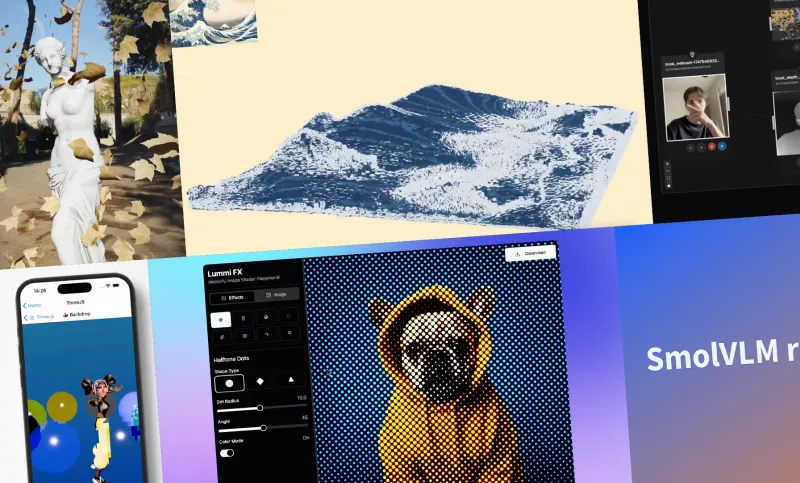The Best of WebGPU in February 2025
February 2025 showcased incredible advancements in real-time physics, AI-powered applications, and large-scale interactive installations. From high-performance fluid simulations to multimodal AI running directly in the browser, WebGPU is continuing to redefine what’s possible on the web.
Last updated: February 9th, 2025Real-Time Fluid Simulations Redefined
This month, WebGPU-powered fluid simulations took a major leap forward. Developers are now leveraging new physics techniques to create realistic water effects that run in real time—even on consumer hardware. These projects prove that browser-based simulations can now rival dedicated software solutions.

WaterBall: Fluid Simulations on a Sphere
WaterBall introduces an innovative approach to fluid simulation by applying Moving Least Squares Material Point Method (MLS-MPM) techniques on a spherical surface. The result? A high-performance water simulation that remains stable even at extreme angles.
This is the latest demo by Matsuoka_601, whose work on MLS-MPM fluid simulations we featured in January. It’s exciting to see how their research continues to evolve, pushing WebGPU to new limits.
The project demonstrates WebGPU’s efficiency, running smoothly on older devices while enabling new possibilities for planetary simulations and real-time physics interactions.
Try it here: WaterBall Fluid Simulation

Utsubo’s Interactive Fluid Simulation for Expo 2025
As part of their Expo 2025 showcase, Utsubo is developing an interactive installation powered by WebGPU-based fluid dynamics. Unlike traditional Smoothed Particle Hydrodynamics (SPH) simulations, Utsubo’s approach uses the Material Point Method (MPM) for higher particle counts and smoother real-time interactions.
This project is particularly noteworthy as it was developed using the new WebGPU renderer from Three.js. Three.js is a popular JavaScript library that simplifies the creation of 3D graphics in the browser. By leveraging its latest WebGPU support, Utsubo achieves significantly improved rendering performance and visual fidelity.
This shift allows for more immersive, large-scale fluid interactions—an essential feature for an installation designed to engage thousands of visitors.
Try it here: Utsubo Fluid Simulation

Shallow Water Physics by Lisyarus
Using a technique called the virtual pipes method, this WebGPU-powered simulation models shallow water physics in real time. Users can manipulate water flow by adjusting parameters like gravity, friction, and velocity, all while watching the changes happen instantly.
The entire system runs entirely in the browser, showcasing how WebGPU enables computationally heavy simulations without relying on external servers.
From Fluid Simulations to AI-Powered Applications
While fluid simulations demonstrated WebGPU’s ability to handle complex physics, AI-powered applications are proving how it can accelerate deep learning models directly in the browser. This month saw the release of several groundbreaking AI projects, from ultra-fast text-to-speech to fully local multimodal AI systems.

Kokoro TTS – High-Speed Text-to-Speech in the Browser
Kokoro TTS is a WebGPU-accelerated text-to-speech model that delivers high-quality voice synthesis entirely in the browser. Unlike traditional TTS systems that require cloud servers, Kokoro TTS runs locally, offering near-instant voice generation with enhanced privacy.
Try the demo: Kokoro WebGPU TTS

Janus Pro – Multimodal AI for Image and Text Generation
Janus Pro is a multimodal AI model capable of both text and image generation, running entirely in a web browser. This system processes and generates results locally using WebGPU, eliminating cloud dependencies.
DeepSeek, the Chinese AI company that has shaken the industry by challenging giants like OpenAI, is behind Janus Pro. Known for pushing boundaries in AI efficiency and cost-effectiveness, DeepSeek has rapidly emerged as a major player in the field.
Janus Pro is one of their latest innovations, a multimodal model that runs directly in the browser using WebGPU, offering high-performance AI without cloud reliance.

SmolVLM – The World’s Most Efficient AI Model
SmolVLM is an ultra-efficient multimodal AI model optimized for browser-based execution. Despite its small size, it outperforms much larger models and is ideal for lightweight AI applications that require real-time performance.

A 13-Year Journey into WebGPU Fluid Simulations
Hector Arellano shares his extensive experience working with fluid simulations, from early WebGL workarounds to fully optimized WebGPU implementations. His article provides a deep dive into the challenges and breakthroughs that have shaped modern browser-based physics simulations.
Conclusion: WebGPU’s Transformational Power
February demonstrated how WebGPU is driving new possibilities in real-time physics, AI processing, and large-scale interactive installations. As more developers adopt WebGPU, we can expect even more breakthroughs in graphics and machine learning. Stay tuned for next month’s highlights!






